Stories
This section explains the history of the Land Settlement Association (LSA) as a national organisation, its infrastructure and management at a local level and the rationale for creating a heritage trail.
The history of the Land Settlement Association (LSA) in general has been well documented by others and it is not the role of this website to cover this in
detail. (See bibliography for further references)
The following two extracts explain the background to the establishment of the LSA:
1.1 'Memories of the Land Settlement Association in Abington 1936 to 1983' 2007/8:
In 1934 Britain had been through five years of economic depression. The mining, steel and ship building industries had suffered a great deal in this
depression and large numbers of workers in the North East of England and Wales had been unemployed for many years and had no hope of working again in the
jobs they had been brought up to expect.
The idea of establishing small farms that could support a family had already been tried after the Smallholdings Act in 1908 gave County Councils the power
to acquire land and establish smallholdings. Many of the early smallholders were ex-servicemen of the First World War but there was little planning put
into training and consideration of the problems of small units.
This experience was behind the ideas that came to establish the Land Settlement Association in the 1930s. There were various voluntary bodies that were
working with the Government to consider ways of relieving unemployment. The Society of Friends (Quakers) had already, on a small scale, settled some
unemployed men on the land. By 1934 the Ministry of Agriculture announced that they would support the setting up of an Association if it could be partly
financed from private funds. By November 1934 the Land Settlement Association had been set up with the help of the Carnegie Trust, the Society of Friends,
the National Council of Social Services and other voluntary bodies. Government funds were provided by the Commissioner for the Special Areas, set up to
consider the alleviation of some of the problems of long term unemployment.
In the first year a benefactor donated an estate of 535 acres at Potton in Bedfordshire and this became the first settlement. In 1935 the Government had
designated certain areas of severe unemployment as Special Areas and appointed a Commissioner. He agreed to fund one third of the cost of six settlements
and Andover was the second purchase. He then agreed to bear the costs of establishing a further 20 settlements, each to support about 40 families from the
Special Areas.
The plan agreed was for 320 holdings in Cumberland, 200 in Northumberland and 1540 in other parts of England. By the end of 1937 land for nearly 1400 of
these holdings had been acquired; there were no compulsory purchase powers. Any land to be used had to be available quickly, purchased on the open market,
be of reasonable quality, in a good location and with accessible roads and water supplies. Then work would have to be done on each estate dividing it up
into holdings, building roads and houses. Each estate would be run by a warden and a staff of technical advisors. The smallholdings would be 5 to 10 acres
each, some being horticultural and some for livestock. Each estate would have a central farm from which it would operate with an estate office and where
buying and selling operations would take place.
The objects of the newly formed Land Settlement Association were described in these four fundamental principles:
Assistance would be given only to group settlements, not to individual smallholdings
Co-operative methods would be adopted for the purchase of the smallholders’ requisites, the marketing of their produce, and the general working of the
scheme
Settlers, both men and their wives, would be carefully selected. In general the Association proposed to select men who had successfully cultivated
allotments
Adequate training and supervision would be provided.'
Published in February 2008 by The Abington History Group
1.2 The Land Settlement Association Charitable Trust
'The Land Settlement Association (“the LSA”), a government-supported initiative, was founded in 1934 at the height of the depression under the auspices of
the Society of Friends and the Carnegie Trust. It was established “to carry out an experimental scheme, with financial assistance from the Government, for
the provision of rural small-holdings for unemployed persons from the industrialised cities”.
The initial programme was for provision of some 2000 smallholdings throughout England and Wales. The holdings ranged from 5 to 10 acres, the small ones for
horticulture and the larger ones for livestock, particularly pigs. By 1938 it had 25 estates of which 20 had been developed containing 1031 let holdings in
total. A further 75 were retained for propagating. At the outbreak of the Second World War, the policy changed to accommodate the need for intensive food
production and only tenants with agricultural experience were taken on. Thus, by the end of the War the LSA had become more of a co-operative with
co-ordinated skilled production and marketing.
In 1947 the Association came under the aegis of the Ministry of Agriculture, Fisheries and Food and, following various reports on the viability of the
Association, it was decided that the scheme should be concentrated on horticulture; pig production was phased out. A further review in the early 1970s
concluded that it should concentrate on intensive horticultural production, mainly of salad crops for the large supermarkets.
In 1983, following yet another review, the smallholdings were privatised and the LSA’s residual centralised assets were sold, the proceeds being appointed
to the LSA Charitable Trust as it is today.
1.3 Bibliography :
- The Small Farm in Rural Economy Co-operation and the Small Farmer Arthur Richmond in The Geographical Magazine 1953
- The Scheme of the LSA Sir Arthur Richmond 1960
- Final Report (Wise Committee) HMSO 1966
- The LSA MJ McCready (Plunkett Foundation) 1974
- The Land Settlement Peter Clarke www.peterclarke.com/Land4.htm
For further information, including archives - Museum of English Rural Life (MERL) at Reading University
Location of LSAs
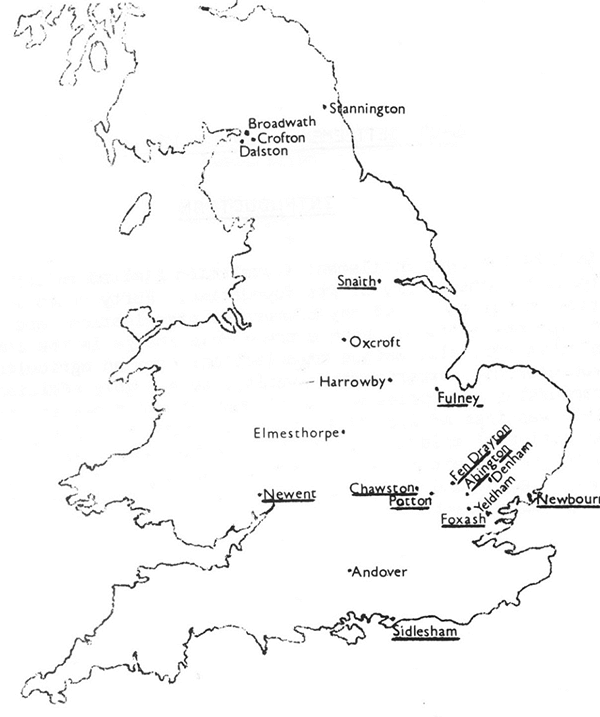
20 LSAs:
- Abbotts Ann (Andover, Wiltshire)
- Abington (Cambrideshire)
- Broadwath (Cumbria)
- Chawston & Colesden (Wyboston, Bedfordshire)
- Crofton (Cumbria)
- Dalston (Cumbria)
- Denham (Suffolk)
- Elmsthorpe (Leicester)
- Fen Drayton (St. Ives, Cambridgeshire)
- Foxash (Colchester, Essex)
- Harrowby (Lincolnshire)
- Low Fulney (Lincolnshire)
- Newbourn (Felixstowe, Suffolk)
- Newent (Gloucestershire)
- Oxcroft (Bolsover, Derbyshire)
- Potton (Bedfordshire)
- Sidlesham (West Sussex)
- Snaith (Humberside)
- Stannington (Northumberland)
- Yeldham (Essex/Suffolk)
Further Information:
Abington (Cambridge)
Book: Memories of the Land Settlement Association
Published in February 2008 by Abington History Group
Chairman: Jennifer Hirsh
Email via Parish Clerk
Fen Drayton (Cambridge)
Book: "Go home, you miners!" Fen Drayton and the LSA by Pamela Dearlove 2007
£8.95 from Pamela at redtiles@mac.com
Newbourn (Felixstowe, Suffolk)
Books:
Newbourne in Short Trousers - Leigh Belcham (2014) costs £8.95
"A History of the Land Settlement Association with particular reference to its Newbourne Estate"
costs £10.35 incl p&p.
Contact: lbelcham1@aol.com
Newent (Gloucestershire)
Contact: Geoff Wood (via website)
Oxcroft (Bolsover, Derbyshire)
Film: 'Settlers In England by Ian Nesbitt
Potton (Bedfordshire) First LSA
The Land Settlement Peter Clarke
Sidlesham (W. Sussex)
Heritage Trail Leaflet
This website!
Books: Sidlesham Past & Present 1947
Sing and Sit Small Marianne Christina Heath (Sidlesham LSA) 1994
Film: MERL Archives 1957
A Life from the Land (2015)
Snaith (Humberside)
Yorkshire Salads still operating based on former LSA smallholdings.
- Smallholdings - house, glasshouse, piggery, chicken battery & produce
- Central Services - Packing Shed, Propagation Unit, Stores, Offices, Property Maintenance, Transport & Central Services + LSA Bulletin
- LSA Staff
120 Smallholdings
In 1936 each smallholding comprised a house, a glasshouse (60 x 30), a piggery with 6 pigs, chicken battery for 250 chickens and four acres of land.
Houses (built by Stirland, Birdham)
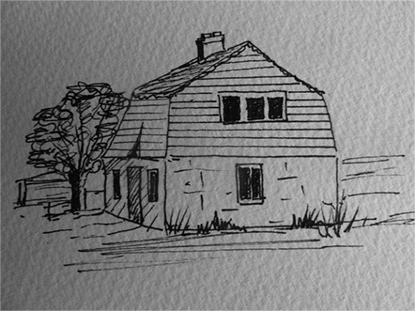
"We have looked into my late Father’s papers and it appears that W Stirland Builders & Contractors commenced building for the LSA in 1936 at
Sidlesham, Keynor, Batchmere and other local areas. Our first contract was for 60 properties. A 3 bed detached house priced at £345, 4 bed mansard house £415 and the semi detached £624 the
pair.
Each small holding comprised of a 60 x 25ft glass house a 250 hen battery building and a piggery for 6 pigs. W Stirland also built properties for the LSA
at Newent, Caversham Reading and Romsey. My father was delighted to have contracts in this area in order to extend his business interest. I do remember
going to Keynor with him on one of his site visits."
Robin Stirland (17/09/2014)
Robin Stirland (17/09/2014)
"Our house is one of the few chalet style houses. It was built by Stirling..his name can be seen on some timbers in roof. Bricks are Midhurst Whites and
tiles. A builder has said it is a raft construction being part concrete and part suspended floor. The house was originally a 3 rooms down and 2 up. The
kitchen had a range and table top bath which adds a new dimension to "bath night". The toilet was downstairs. Access to the stairs was via the sitting
room. We have exposed the original brick work on what was outside wall and revealed the windows that were either side front door. This brick work now shows
traces of ministry green paint. We have also kept the original cast iron fire place in one bedroom. `During the 87 storm we found out that some of tiles on
the hip end were very old peg tiles which I feel may have come from barn as a speedy repair, perhaps even when bomb dropped. Hence when the LSA extended in
60's they built over the sewage pipe. Our house is meant to have been a Canadian "off let" during the war."
(Becky Wilson, No 45)
(Becky Wilson, No 45)
Staff Houses
Staff houses included numbers 3a, 5, Tonges Cottage, 26, 27, 31 & 35 as well as 35a & 35b which were built later for lorry drivers.
Various houses (for example, Nos 67, 68, 77) were occupied by LSA staff on a temporary basis when tenants left until they were replaced. In these cases the
smallholdings (land) would usually be sub-let to other tenants.
"All houses had cess pits and main drains came in early 80's/ Fred Green cleaned out cess pits. In his daughter, Sharron's memories of Sidlesham as a child
she also recollects the odours of cess pit collections and rotting "mangolds" along the Ham Road. We think that the main sewage pipe went down our lane in
early 80's. Residents then paid to be connected as and when they wished. We still do not have gas down here like more civilised members of the village
along the main road. I think Mutton Farm paid to have gas main put down to their property. A lot of houses still have a little shed outside the back door.
This was modernisation by the landlords for the women as this was the wash house. Nothing but hard graft all the way round. I presume the copper had pride
of place. During the summer the water pressure would have dropped greatly by 10.00 am due to growers watering. It meant that washing powder in machine was
not always used."
(Trevor Wilson 17/08/2014)
(Trevor Wilson 17/08/2014)
Glasshouses
Landlord Glasshouse - so called because the tenants paid rent for them. Originally heated with a coal fuelled boiler.


Later additional dutchlights were built with wooden frames, which could be detached and used like cloches for lettuce and other crops on the ground.
Later still came metal framed glasshouses with a hand-cranked ventilation mechanism.
"As from 1st October, 1969 the repairs to the majority of these (glass) houses become the tenant's responsibility, or you have the option to request that these be dismantled"(Bulletin 1063)
"Demolition of Landlord glasshouses. Mr Newton would like to know of any further landlord's 60 x 25 glasshouses which tenants require to be demolished this autumn". LSA Bulletin 1188 August 1971)
"As from 1st October, 1969 the repairs to the majority of these (glass) houses become the tenant's responsibility, or you have the option to request that these be dismantled"(Bulletin 1063)
"Demolition of Landlord glasshouses. Mr Newton would like to know of any further landlord's 60 x 25 glasshouses which tenants require to be demolished this autumn". LSA Bulletin 1188 August 1971)
"Another thing that triggers the memory is heating. The two main providers of glasshouse heaters were Greaves and Craig. These ran on heavy fuel oil,
either paraffin or 35sec oil (effectively red diesel). Holdings had fuel tanks high up on solid piers to hold the heating fuel. Corrals was one of the main
suppliers based at the fuel dump just off the A27 by-pass by the Bognor bridge. Greaves were adapted industrial heaters and Graig was a dedicated
horticultural product I think based in the Channel Islands. The Greaves machines were relatively large and had powerful fans pumping hot air through a
system of ducting fixed in the greenhouses. The fans were usually single phase electricity and the lights in the houses would dim briefly down the avenue
when any of these started up. The Craigs were a characteristic mid-blue colour, smaller and probably more efficient. The Craig heaters tended not to have a
heat exchanger system and pumped exhaust fumes (rich in CO2) into the greenhouses. Another one was the small portable Tropical heater which ran on
paraffin. These were small cylinders about 1½metres long and 400mm in diameter with a burner and fan at one end pumping hot exhaust gases out of the other
end. Usually a grey/blue and orange colour."
(Stefan 12/01/2015)
(Stefan 12/01/2015)
"Some GH were heated by "salamanders" or paraffin heaters which would burn for 8 hours. The art was to light them as late as possible for frost protection
so that they would burn through until sun had come out and frost begun to lift. Air was circulated by electric fan. Very Heath Robinson but very effective.
They also gave off CO2 which was beneficial to crop growth. "Sallys" would light up the GH and look quite amazing as they were reflected in other GH.
Growers would laugh about lighting techniques and how the flames would shoot out of the chimney."
(Trevor Wilson 17/08/2014)
(Trevor Wilson 17/08/2014)
Produce
Pigs (Bacon)
LSA Bulletins make reference to weaners, porkers and baconers.
Extracts from Bulletin
Slaughter House at Stockbridge Roundabout, Chichester.
Chickens (Eggs)
Initially free range on the smallholdings, Sidlesham was the first LSA to trial battery production. Tenants were reprimanded for eating too many eggs and
thereby reducing the number sent to the packing shed, reducing the profit of the LSA. (LSA Annual Report 1939)
Goats
Geese
Crops
Early days: Mangles (fodder for pigs), eggs (chickens), bacon (pigs), potatoes, tomatoes, lettuce (2 crops), cucumbers, celery, leeks.
1958/59: Market Information (LSA Bulletin 528 September 1958) Tomatoes, cucumbers, French Beans, Celeriac, Red cabbage, onions, Brussel Sprouts, Mushrooms, Radish, Gooseberries, Cauliflowers (Bulletin 559) Blackcurrants (Bulletin 562) Gladioli (Bulletin 563), Chrysanthemums (Bulletin 586), Eggs Large 5/- (25p 2015) + Standard, Medium & Small.
1959: (Bulletin 553) 51,012 crates of lettuce brought back £38,241 to the estate (£800,000 at 2015 prices).
1959: (Bulletin 579) 231,123 baskets of tomatoes sold for £113,389 (£2,370,000 at 2015 prices).
1962: Total celery order up to 370,000 (LSA Bulletin 705 April 1962.
1964: Market Information: Celery, French Beans Marrows, Cauliflowers, Strawberries, Courgettes, cucumbers (Bulletin 819 July 1964) Tomatoes (Bulletin 822).
1968: Market Information: Pumpkins, Red Cabbage (Bulletin 1038).
1973: Market information: Lettuce, Tomatoes, Chrysanthemums, Green peppers, American Spray, radish, celery, marrows, cucumbers, French beans, Blue Beans, Gladioli, pumpkins, celeriac.
1982: Market Information: Tomatoes, celery, cucumbers, Lettuce, Green Peppers, Courgettes, Aubergines.
LSA Support Services
Packing Shed
The packing shed was where the tenants produce was bought by LSA staff to be sorted, graded, weighed and packaged before being sent off to market.
When the LSA was first established there were packing sheds on each of the three estates at Keynor (Chalk Lane), Fletchers (Street End Road) and Batchmere
(First Avenue), amalgamating to the Keynor site in the 1940s after the war.
Propagation Unit
The propagation Unit (known locally as the props) was where seedlings and young plants were grown for the tenants to transplant on their smallholdings.
When the LSA was first set up there were separate units on the different estates - Keynor (No 3), Fletchers (Nos 58 & 69) and Batchmere (No 108),
eventually all amalgamating at the Batchmere site.
Central Services
A Central Service Department organised transport and machinery on the LSA.
Initially there were stables on Street End Road and Almodington Lane for shire horses which were used to pull trailers to collect the produce from the
smallholdings and distribute the seedlings from the propagation units.
"There were two green Bedford lorries. Ron Bushell at Almodington had one. The other one was bought by Dick Agate from Barnham. Last time I went there Dick
was keeping the lorry, which he bought as a hobby thing, in the barn at the back of the house. The LSA tilts from the tractors were always used for the
fete.
The tractors were used to bring the produce to the packing shed. They each did a route with a tractor and trailer (tilt) and with a mate, usually sitting
or standing on the trailer. The tenants who had produce to be picked up would leave out a board or, sometimes, an oil drum, with a big white P on it to
signify produce. If there was a lot to be picked up the lorries would also be sent round.
Tractors were used to deliver to the holdings as well, boxes or whatever was needed. The lorry drivers would sometimes work on the tractors but their hours
were different in that they were used to take the produce to market after it had been packed."
(Sharron Green)
(Sharron Green)
The tractor drivers also provided other central services such as threshing and ploughing (in the early days), then rotavating, soil sterilisation, hedge
cutting and ditching.
"While I remember, soil sterilisation was an annual event taken seriously by most of the tenants. In the early 60's it was still done by steam. Furrows
were dug into the soil in the greenhouses and pipes with holes were Laos in them and covered up. The whole area was then covered by a sheet of plastic,
presumably tarpaulins earlier on and then connected to this great big boiler "thing" that looked like Stephenson's Rocket. It was basically a steam
locomotive boiler running on anthracite coal without any running gear. It was cylindrical made of riveted steel and a great big chimney. It had large rear
wheels and smaller front wheels and was towed by a tractor to the site where it was to be used.
These great monsters would have been a familiar sight to be seen travelling the local area to the next site.
More recently (circa late 70's) they were gradually replaced by companies like English Woodlands providing chemical sterilisation, usually with Methyl
Bromide, a very dangerous chemical.
Other methods would have been spraying the inside of the greenhouses with a dilution of formaldehyde using the Cameron diluters which were otherwise used
for the trickle irrigation for feeding and watering tomatoes and the overhead spray ones for lettuce and celery.
When some tenants finished the season they would just make a pile of the irrigation equipment somewhere until the next time it was to be used. The more
successful growers would carefully sterilise and wash the equipment in tanks of sterilising solution before careful packing them away in tied up coils
protected within old compost bags.
This process was an integral part of the annual calendar."
(Stefan B. 12/01/2015)

(Stefan B. 12/01/2015)

Property Maintenance
Property maintenance of the tenants' houses and outbuildings was undertaken by a team of workers, including specialist plumbers and carpenters.
Stores
"Did you know that Sidlesham Store is open 9.30 to 10.00am and 2 to 3 pm and Batchmere Store from 2 to 3pm daily. Customers are welcome at either store.
We carry a stock of over 800 items, The following are a few selected at random - Ever-ready Torches and Batteries, Toilet Rolls, Rubber Boots (three kinds,
various sizes), Protective Clothing, Gloves, 5 kinds of Broom Heads, 4 kinds Hand Brooms, 2 kinds Electric Bulbs, 3 makes Rubber Tyres and Tubes, Knee Pads
for lettuce planting, Polythene in 14 different sizes, Watering Cans, Powder Blowers, etc. If we haven't got what you require we shall continue to try and
provide it in the shortest possible time."
(GG Clarke, Storekeeper LSA Bulletin No 785, October 1963).
(GG Clarke, Storekeeper LSA Bulletin No 785, October 1963).
Offices
Management of tenants' accounts (passbooks)
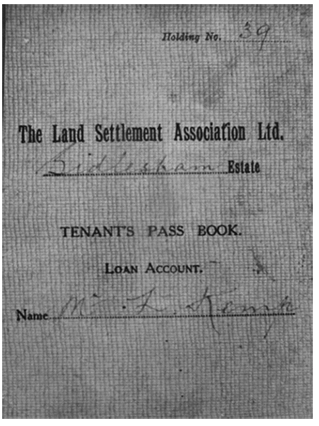
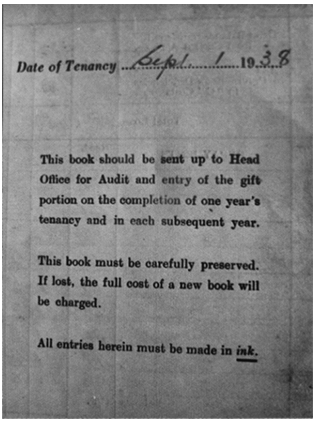
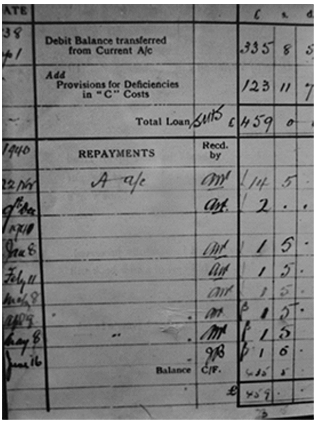



R Plan
"All new tenant's went on the "R Plan" for the first 2 to 3 yrs. This was a pre-agreed income from the holding to prevent tenants from spending too much
when returns came in. Do not know what R stood for but it was source for a lot of dry humour eg we managed to buy ourselves some chocolate biscuits this
month."
(Becky Wilson)
(Becky Wilson)
Markets (Covent Garden), Birmingham, Bristol, Holland, Germany
‘The old Covent Garden Market closed on Friday 8th November and the new Nine Elms Market opens on Monday 11th November. As this estate is a large supplier of produce to this market it was felt that the estate should co-operate with the wholesalers concerned in having fresh produce on the stands on Monday 11th November’ (Bulletin 1355 1974)
‘We shall shortly be discussing with the representatives of Marks and Spencers the supply of celery to their stores, pre-packed in polythene bags. The packing to be carried out by the tenant to specifications laid down by M&S’. (LSA Bulletin 717 July 1962)
Slaughter House (on A27 Chichester Roundabout) - LSA Bulletins: reference to weaners, baconers & porkers
Slaughter House on A27 Chichester Roundabout
Bulletin: reference to weaners, baconers & porkersLSA Bulletins
A weekly Bulletin was produced and distributed to all the tenants. This gave prices, collection times and information reminders as well as social
activities. Norman Dixon (No 50) had copies 1958-83 - a fascinating insight to life on the LSA and in the village as a whole.
Glossary of LSA terms
Dutchlights
As more produce was being grown under glass, tenants built dutchlights - a wooden framework of glass panels which were multi-purpose as they could be
dismantled and used like cloches. Later glasshouses had metal frames with hand-cranked ventilation.
Flogging
All produce was to be sold through the LSA. Tenants were not allowed to sell privately, which was known as flogging and was a sackable offence.
"He was selling more down the Highleigh Pound than was going to the packing shed and he got his cards."
Head Office Notice (LSA Bulletin No 1,169 April 1971)
Illicit selling, Arbitrator upholds notice to quit.
On 29th September 1970 a tenant from Chawston Estate was served with a notice to quit for illicit selling. The tenant chose to refer the notice to
arbitration under the Agricultural Holdings Act 1948. The arbitration was heard at Bedford on 3rd march 1971. The Ministry was represented by Standing
counsel and the tenant was also legally represented. The arbitrator made the award to the effect that the notice to quit served on the tenant was valid.
The arbitrator also awarded his costs and a proportion of the Ministry's costs against the tenant.
Fragmented holding
Most of the tenants houses were built as part of their smallholding. Occasionally they were 'fragmented' as in the case of No 65 where the smallholdings
was on the opposite side of Street End Lane.
Landlord Glasshouse
Wooden framed fixed structure (60 x 30ft) heated by a coal fired boiler. 'Landlord' because the tenants paid rent to the LSA.
Off-let
Vacant houses were often occupied by LSA staff. Where this happens the smallholding was sub-let to another tenant.
Queer Gear
After the closure of the LSA in 1983 some tenants experimented with different crops/produce such as aubergines and kiwi fruit. Today some growers have
developed niche markets growing specialist produce such as Acer Nursery (45) with courgette flowers (queer gear) for restaurants and Kevin Freer (No 100)
with Chinese PYO produce (funny fruit).
Further information:
Sidlesham Past and Present 1947
Sit and Sing Small - Marianne Heath 1994
LSA People (Staff & Tenants)
LSA Staff:
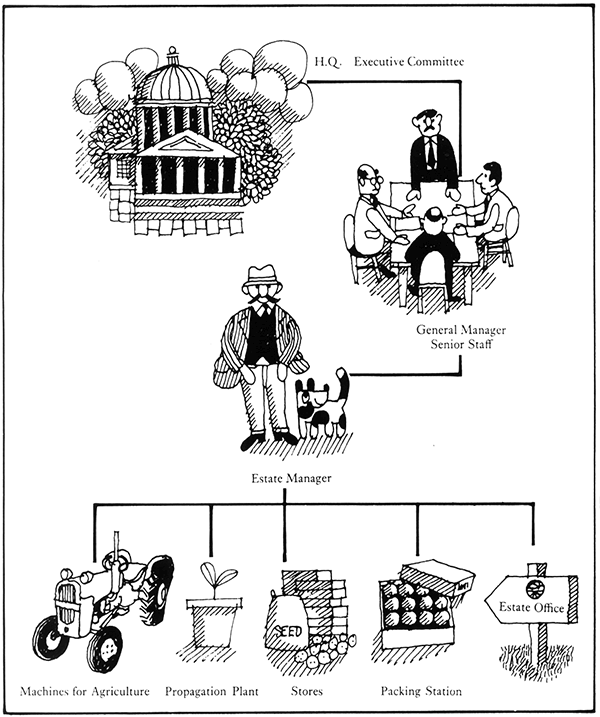
Estate Manager
- H. A. Campbell 1936 - ?(Warden)
- Bertie Cutler ?
- William (Bill) Constable 1945 - 1952
- George Sutton 1952 - 1964
- A.J.S. Cox 1964 - 1965
- Tom Scott 1965 - 1983
Other Management Staff
- Assistant General Manager
- Estate Accountant
- Livestock (Chickens and Pigs)
- Central Services Department (including transport)
- Propagation Department
- Packing Shed (20/30 staff
- Property Maintenance
- Storekeeper
Names of LSA staff (and tenants) can be found in People section of the website, with additional information about their properties in the Stories section.
A collection of photographs compiled by a long-standing tenant, Charlie Rowe, provided the initial interest for a total newcomer to the village to become
fascinated in the overall concept of the Land Settlement Association (LSA) and its impact on the local community.
Although not widely known, much has been written about the development of the LSA at a national level. The creation of a heritage trail in Sidlesham was
seen as our way to commemorate the impact of the LSA as a national event at a local level.
A successful application was made to the Heritage Lottery Fund. Archive films were purchased from the Museum of English Rural Life (MERL) at Reading
University. These films have been shown at local meetings and seen by more than 500 people. As a result contact has been made with the relatives of 25 of
the original 'settlers', the unemployed miners and shipbuilders who arrived in the village in the late 1930s as well as over 50 former LSA tenants and
staff.
Most of the roads, houses, ancillary buildings and central services, which were built specifically for the LSA on what was previously open farmland, are
still in existence today and their locations have now been brought to life by stories told by the people who lived and worked on the LSA.
A heritage trail leaflet with a map has been produced which enables visitors to stroll around the village and explore the development of the LSA. This website
has also been developed with additional relevant information and a version of the trail which can be downloaded and used 'offline' on mobile phones.
If you have further information which could enhance the website please do not hesitate to contact me via the link on the home page.
Enjoy the trail.
Bill Martin
If you would like to create your own trail, contact Tangent Web Design Ltd. Copyright of respective owners 2015.
